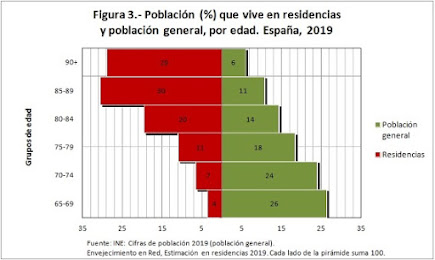Innovation and Nursing Homes
After the emergence of the SAR-Cov2, a lot of people is talking about the approach to the change of model of the nursing homes for dependent elderly people, even more a lot of people who don’t know the reality of social services are giving opinions on this theme, digressing and proposing measures that are far from models of equity in our society. Although there are different interpretations and validity of the proposals, there is a consensus of all that the model should change ant the direct attentions to the users must be improved.
The evolution trend of our populations pyramid is known to all, in which there will be an increasing number of people over to 65 years, and therefore a greater number of dependent people, who require specialized care.
Face to this situation, any action must be considered taking into account demographic evolution (due to the increase in older people both in absolute and relative value) and above all taking into account economic stability.
So we start from the basis that more services are required, with fewer people who will offer them, with the desire for higher quality related to a greater need for care, and with the counterpart that there must be economic stability. Faced with this situation, experts like Josep de Martí propose ideas for “sufficient, optimal and excellent” services, and each proposal must be accompanied by the corresponding “demographic and cost analysis” to be taken to be valued.
Faced with the dissociation of how care can be given to a growing group if fewer and fewer people have to provide it, must be imaginative solutions should be sought to this imminent problem and we cannot be ruled out one of them is the incorporation of the hand of non-human work in the attentions of people.
We could consider social services in our country as a young sector, in terms of management, being able to easily find waste (or changes) in the efficient management of resources and processes. This youth makes it possible to benefit from other efficient management systems after overcoming the reluctance to change that this may entail, both for service provider entities such as administrations, users, family environments or society as a whole.
Other sectors are much more advanced in this process, and have even incorporated robots to make cars, serving the reception of a hotel in Japan or directing traffic and giving directions in Dubai.
This possibility should be studied but asking ourselves if what would happen to human relationships and interactions in the provision of care has been taken into account, if we are prepared for this possible change or if people would accept being cared for by robots.
Some studies already show that people in nursing homes would accept the use of robots for some basic tasks such as medication or assistance at home, but they are concerned about the loss of contact with people, especially because of the actions of a more intimate nature such as hygiene. Although it may be that with the new generations of digital natives they want to have more intimacy and prefer the opposite.
This point has not yet been raised and we can be found that a large part of the population is reluctant to incorporate technologies in the residential field, but it is a process that will inevitably be incorporated, and justifiable by analyzing the areas in which we can find them.
For many years it has been implementing the Telecare button system in homes, but progressively we see other options such as applications, Smartwatch that can warn in case of falls, virtual assistants such as Siri or Alexa, presence sensors or smoke detectors type alarms, smart pillboxes, butler services or small social robots.
Despite the lack of speed that one might think on the part of the administrations, we find that they have already implemented email, digital signatures, virtual entry records and forcing nursing homes to implement management programs for optimization of resources.
Nowadays we can find a resident using mobile phone and internet, or even especially with the situation by the pandemic, making video calls, and we know that this process will continue.
Although a lot of people think that the technology replace jobs, that is not true, but rather it will improve care improve care for residents, and the reason is because after an analysis of inefficiencies, such as the vertical displacement of the buildings, we find that part of the employees' time are not in direct relationship with the users, so by minimizing these times, better attention could be given to the people who live in the nursing homes.
Another question to decide is what type of technologies or efficient ways of working can help this objective of providing better care, so the best option would be to analyse some of them in detail in other publications.
Written by
Jose Luis Monserrat
Registered Nurse
Manager of a nursing home complex in Barcelona Spain


Comments
Post a Comment